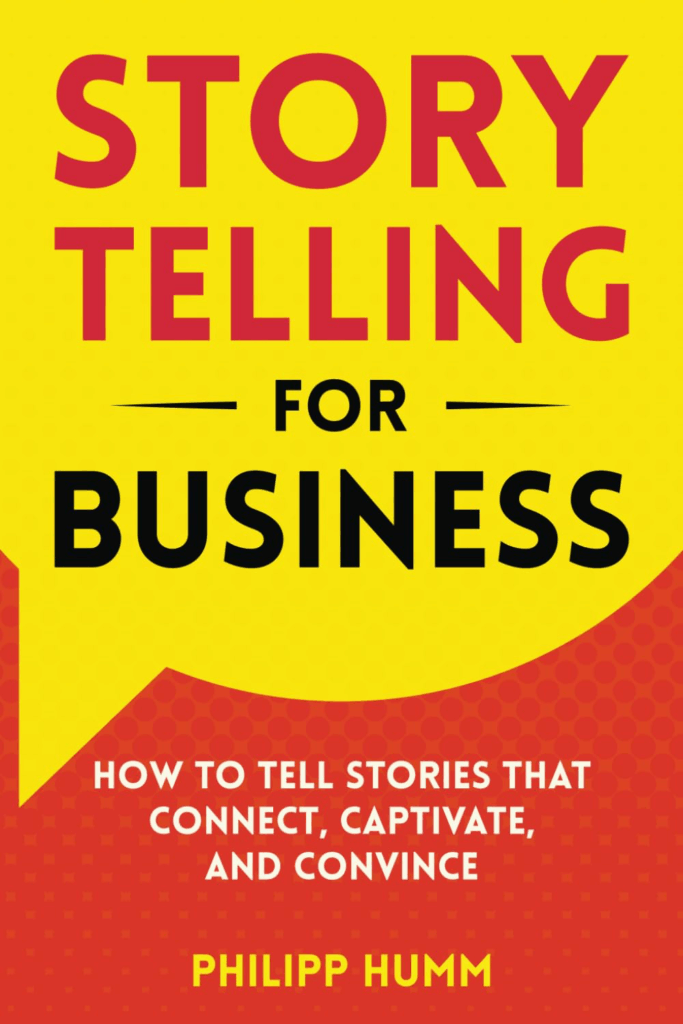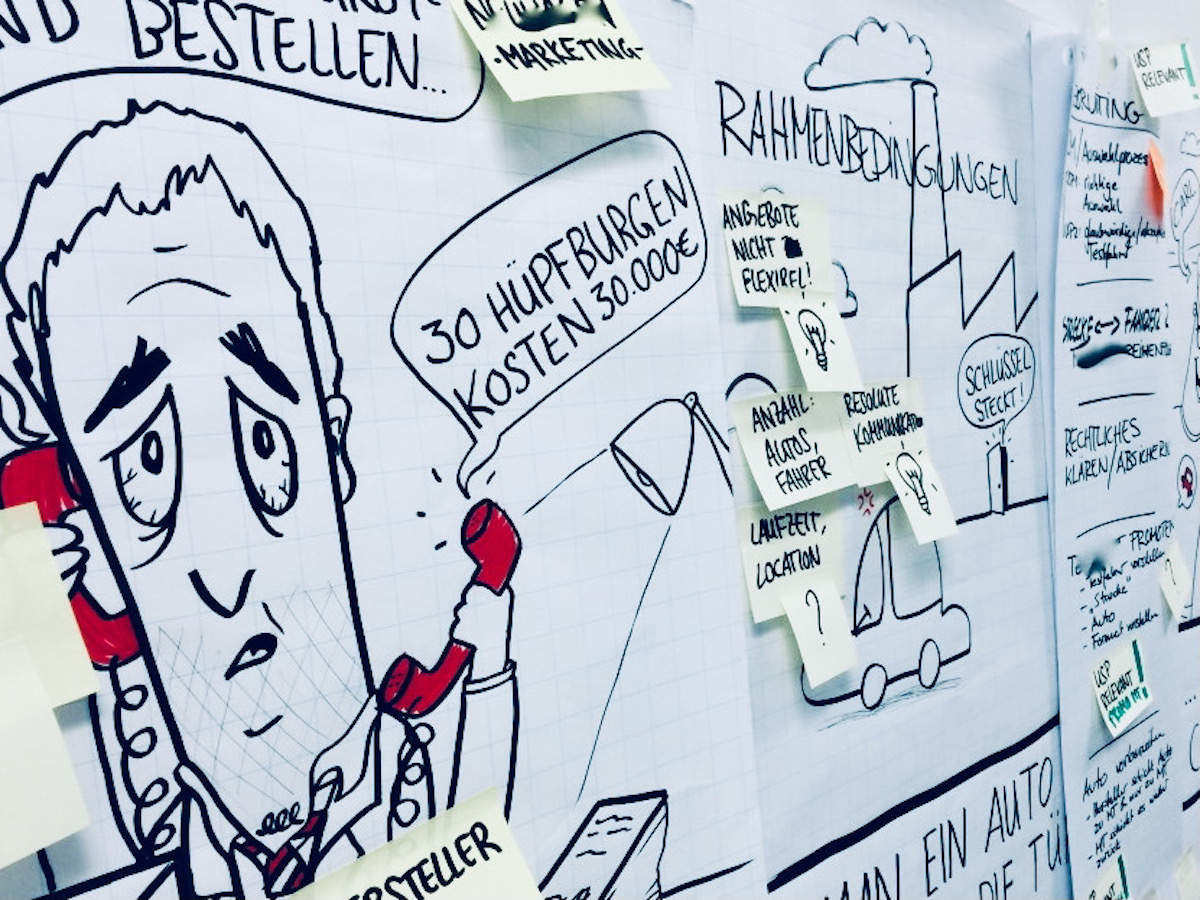Table of Contents
TL;DR – mockups are fine, stories are better
Too many product ideas are shared too late and too abstract — via mockups, epics, or business cases that lack emotional context. Storytelling is a powerful way to create clarity and alignment earlier. Instead of pitching solutions, use story-based formats to frame problems and build shared understanding.
Here’s how:
- Start with personas – sketch key user traits in their real environment.
- Frame user needs visually – show what matters before defining features.
- Tell an ideal scenario – use a short narrative to describe how users interact with the system and each other.
- Keep it rough – storyboards and quick drafts are enough to spark discussion.
- Invite feedback – good stories provoke conversation, not agreement.
A clear, well-told story is often the first real prototype — and one of the most effective tools to drive smart product decisions.
What’s the deal with storytelling?
I faced this challenge as an agile coach leading a team. The task was to expand the portfolio with a new product for the upcoming sales cycle. We conducted several workshops inspired by Design Thinking to generate, assess, and eliminate many ideas. Ultimately, the team deemed one product idea promising and began developing it conceptually, using tools like a Product Canvas and previously created personas.
It was time to present the concept and engage in discussions with internal stakeholders, the management, and selected customers to gather crucial feedback early on for the decision-making process, determining whether the idea can be pursued in its current form, with modifications, or if it needs to be reevaluated entirely.
Old behaviour patterns in an agile environment
At this point, I will allow 30 seconds for consideration and ask the question: What would you do next? The most likely top four responses are as follows:
- “I’d ask my Product Manager to create the first mockups so we can better understand the user flow.”
- “As a Product Owner, I’d move into a requirements workshop as soon as possible to break down the stories and get an initial estimate for effort and timing.”
- “As the Head of the Business Unit, I’d prepare a concept paper by next week and calculate a basic business case.”
- “As the Head of IT, I’d first ask the team for a feasibility check to see whether we can realistically deliver this from a technical standpoint.”
What happens in reality, even in a self-proclaimed agile environment? The concept is developed over several weeks within a small group, possibly supported by market research, approved by decision-makers, and then primarily presented to colleagues in formats such as a company meeting, All Hands, or similar.
The typical process is as follows: Based on measurements, research, and interviews, we have discovered that […]. Therefore, we will implement the following project […], the initial mockups are shown here…, based on the initial estimation, we will need […]. If the product management has embraced the Build-Measure-Learn principle – which unfortunately I have not seen fully implemented in any company so far – the relevant KPIs that the team and responsible Product Owners commit to will also be mentioned. That’s all.
The reaction? Receivers develop an emotional detachment from the product and feel like decisions have been made without their input. What’s even worse: the WHY isn’t clear. So, why are we doing this, what problem are we trying to solve, and for whom?
“The single biggest problem in communication is the illusion that it has taken place.”
George Bernard Shaw
In one of my previous roles as a Scrum Master at a company, I took the effort to ask some listeners directly after such presentations what they had taken away and what it meant for them and their future tasks. The results were disappointing, with the retention rate being almost zero despite colourful images and multimedia support. To quote George Bernard Shaw: The single biggest problem in communication is the illusion that it has taken place. Or as Paul Watzlawick said: The major problem in communication is the illusion that it has occurred. But why is this the case?
Storytelling – We are too old for stories
The narrative, the underlying story, is missing. Throughout history, people have used storytelling (known as Storytelling in modern terms) to convey messages. The Bible is the most well-known example, as it is a collection of stories and parables.
The visual representation of everyday stories in images can also be seen in the cave paintings of Lascaux, dating back to the 17th-15th millennium BC. Additionally, consider fairy tales and children’s stories, such as Struwwelpeter, which play a crucial role in child rearing by metaphorically conveying certain behavioural principles.

Is it not irrelevant for a logical adult in the 21st century, especially in the software industry, to engage in storytelling akin to the higher Waldorf school within the challenging world of business? Let’s explore Wikipedia’s perspective on the art of storytelling:
Storytelling is the social and cultural activity of sharing stories, sometimes with improvisation, theatrics or embellishment. Every culture has its own narratives, which are shared as a means of entertainment, education, cultural preservation or instilling moral values. Crucial elements of stories and storytelling include plot, characters and narrative point of view. The term “storytelling” can refer specifically to oral storytelling but also broadly to techniques used in other media to unfold or disclose the narrative of a story.
wikipedia.org
On the level of User Stories, we strictly adhere – often overly so – to the User Story principle. A skilled Scrum Master will prompt stories at the start of a retrospective, recounting the experiences team members had during the past sprint. The most successful companies all commence with stories that are crafted and nurtured as myths – a prime illustration being Coca Cola: From medicinal tonic to a global fizzy drink.
Good stories evoke empathy for the protagonists, thus directly promoting engagement with the customer and their issues and needs. Businesses often struggle with this when it comes to new products, projects, or strategies, although it is crucial to bring the organization along to the next level or levels at this point.
If and when it does happen, it is often only after completion during the marketing phase, which is laborious and expensive when done by an agency and targeted at an external audience.
First comes the issue, then the solutions
Returning to the challenge faced by my team, the product idea proved to be more complex or rather challenging after the initial analysis of the market environment and target audience consideration than originally anticipated. We wanted to engage in discussions with other teams, colleagues, and the management quickly for this very reason, in order to determine as early as possible whether we are on the right track.
Our aim was to select a presentation format that is concrete enough to convey the basic idea and the value-adding nature of the approach, yet abstract enough to avoid getting lost in product details at this stage and closing off the view to alternative approaches.
“Participants were surprised by the complete absence of a traditional PowerPoint presentation.”
We discussed as a team the possibility of creating a short Lo-Fi video, but dismissed the idea due to time constraints and lack of expertise. Fortunately, the responsible product manager was able to quickly produce meaningful images on the spot. Together, we outlined the different phases of the storyboard while she drew the corresponding illustrations on flip chart paper. It was noticeable from the outset that, in comparison to previous projects, we did not focus on feature details but remained at an abstract level, enabling us to progress much faster than usual, i.e.:
- Sketching key audience traits (personas) in their natural context
- Visualizing user needs to derive the core problem
- Outlining an ideal scenario: how protagonists interact with the system and each other — based on the classic user or customer journey
In less than two hours, we created a series of images to illustrate the key components of the product idea. The presentation for the stakeholder teams, business development, and management representatives took place in the afternoon. Initially, participants were surprised by the complete absence of a traditional PowerPoint presentation. Instead, the team collectively walked through the visual story. It was explicitly agreed that no detailed functions would be discussed during this process.
The effect was astonishing; for most of the meeting, we maintained the intended direction and focused mainly on the target audiences, their needs, and how to position the product idea in the market and against competitors. Rather than focusing on costs and project durations, we prioritised examining customers and their requirements, highlighting unique features and potential marketing opportunities over technical feasibility.
By the conclusion, we had sufficient groundwork to determine our next steps regarding the idea. Additionally, this provided Business Development with a narrative for initial meetings with selected potential clients. The feedback received from these meetings was incredibly beneficial for the team and had a continuous impact on the further evolution of the concept.
Storytelling – “The whole idea is to kill your own baby.”
There is another advantage compared to the traditional approach. The more specific and detailed a product idea is developed before being confronted with reality, the higher the costs incurred so far and hence the economic risk. In addition, the emotional attachment of those involved to their product baby increases so much that it becomes increasingly difficult to fundamentally question it again after a certain point. “The whole idea is to kill your own baby – as fast as possible […] Are there any ugly babies out there? Yes, but never your own, you protect it, the more you feed it, the more you want to see it walk […]” [Københavns Erhvervsakademi]. See also Pretotyping – Fake it before you make it!
“The whole idea is to kill your own baby – as fast as possible”
Københavns Erhvervsakademi
We displayed the illustrations prominently in a workroom, akin to an art exhibition, which would later become the team’s central hub for further development. This involved engaging in discussions with stakeholders and delving deeper – such as creating initial testable paper prototypes for the user interface or identifying legal considerations.
It was noticeable that the storyboard evolved over time as the team incorporated new insights and ideas. This gradual development brings the story to life through simple prototypes, alpha testing, and eventually with initial reference customers.
In many cases, a storyboard combined with a product canvas and the persona(s) can replace the traditional concept paper, transforming it into a tangible and dynamic artifact – akin to a user story that acts as a promise for valuable discussions. This method represents the simplest and most cost-effective form of a prototype, not to test technical feasibility, but to gather initial indications of the product’s market viability.
Book recommendation
Click, buy, and enrich me – my literature recommendation on the subject and an enlightening read on Story Telling: Storytelling for Business: How to Tell Stories that Connect, Captivate, and Convince

Hero image: excerpt from the story board by Martin Heckmann


Leave a Reply